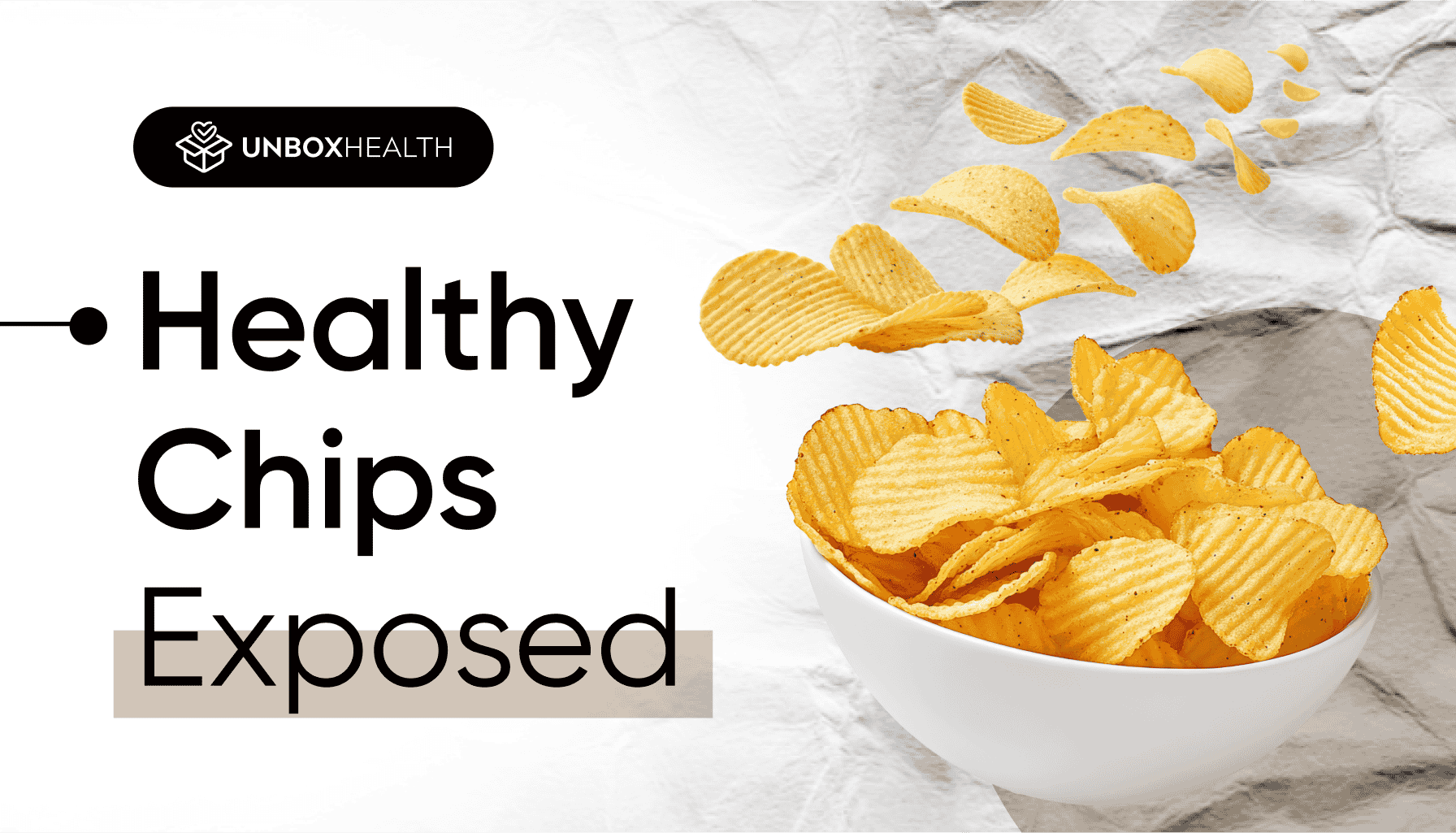Let’s be honest – chips are more than just a snack. They’re an emotion.
Be it a cricket match, a road trip, or just a lazy Sunday Netflix binge – chips are always there. Remember those birthday parties in the ’90s? No cake cutting felt complete without that packet of salty goodness. Even today, for kids, chips are a must-have; for adults, it’s that go-to comfort food we reach for at 4 PM when the hunger pangs hit. And that’s why, at Unbox Health, we decided we couldn’t ignore them anymore. Chips matter; just as much as your daily groceries do.
So here we have launched our latest category: Chips & Puffs Ratings, where we decode the so-called “healthy” snacks flooding the shelves.
The Harsh Truth
We tested a wide range of chips and puffs from the classic favorites to those labeled as baked, low-fat, low-sugar, or high-protein. And the results? Over 80% of these products had poor nutritional profiles. Yes, even the ones that appear in your kids’ tiffin’s or your own “guilt-free” snack stash.
A Growing Market… at a Cost
India’s snacks market reached ₹46,571.3 Crore in 2024 and is expected to more than double by 2033. Urban lifestyles, rising incomes, and Western food influences are fueling this boom (1). But behind this shiny growth lies a bitter truth: our kids’ health is paying the price. Ever wondered: “I eat clean now, so why did I get sick?” Well, the answer might lie in what we’ve eaten consistently over the years often without realizing the damage.
So, What’s Really Hiding in Your Chips?
Cancer Risk: Acrylamide, the Silent Culprit
Most fried potato chips (FPCs) contain acrylamide, a compound formed during high-temperature cooking. According to scientific studies, acrylamide is a known carcinogen and neurotoxin. And guess what? Potato chips have the highest concentration up to 4,318 ng/g, which is 4x more than even French fries (2).
The more chips you consume, the more acrylamide builds up in your body. That’s a long-term risk in every crunch, especially those consumed from a young age.
Heart Trouble: Sodium, Trans Fats & Deceptive Labels
One regular packet of chips can contain 172 to 1800 mg of sodium per 100g (3). That’s enough to take a big chunk out of your daily limit especially for kids.
Add to that the trans fats the kind that raises bad cholesterol and increases your risk of heart disease. Even chips that claim “zero trans fats” can contain up to 0.6g per 100g (4), simply because labeling laws allow brands to round it down when portion sizes are kept unrealistically small (10–14g).
Empty Calories: High on Crunch, Low on Nutrition
Let’s be real chips are calorie-dense and nutrient-poor. They offer very little by way of vitamins, minerals, or fiber. This leads to a dangerous combo of:
- Overeating
- Digestive issues
- Weight gain
- Nutritional deficiencies
Kids get full, but their bodies remain undernourished. It’s malnutrition in disguise — calorie excess with zero benefits.
The Urban Adolescent Crisis
In a study of 1,026 urban teens aged 14–16 years in Kolkata, 70% reported eating three or more servings of energy-dense snacks (including chips) just the day before (5). The average? A shocking 6.25 servings/day – the highest of any food group tracked. This shift from home-cooked meals to easy packaged snacks is part of a bigger nutrition transition across urban India. It’s creating a double burden: obesity and nutrient deficiencies – both at once.
Where Does That Leave You?
That’s where Unbox Health steps in. We’re India’s First Ratings Platform for Packaged Foods and Health Supplements – with no brand involvement, ever. Every chips & puff packet you see on our site is tested independently, with full transparency. No paid promotions. No bias. Just real data, from FSSAI-approved, NABL-accredited international labs, so you can finally make informed choices for yourself and your kids.
What Makes Unbox Different?
- Highly Accurate Testing: Every product is tested across 3 premium international labs.
- Label Accuracy: We verify if what’s claimed is actually true.
- Toxicity Checks: We test for major contaminants like acrylamide, trans fats, heavy metals (lead, cadmium, mercury), and aflatoxins covering both process-related and naturally occurring toxicants in ingredients and packaged foods
- Nutritional Profile Ratings: You’ll know exactly how each snack stacks up.
- Transparent Reports: Every lab-test report is publicly available for you to read and judge.
So, Are Healthy Chips Really Healthy?
Some might be.
But most are just riding the wave of buzzwords – “baked,” “multi-grain,” “low-fat”, while hiding salt, sugar, trans fats, and carcinogens behind slick packaging. Before you drop another packet into your cart, check the ratings on Unbox Health. Because the small choices we make daily especially the ones our kids grow up with matter the most.
Check out unbiased lab-tested ratings of “Chips & Puffs” on Unbox Health along with their detailed lab reports.
About Unbox Health
Unbox Health: India’s First Ratings Platform for Packaged Foods and Health Supplement Tired of biased reviews and never-ending claims? At Unbox Health, every product is tested at multiple premium FSSAI-approved NABL-accredited international labs – 100% independently, transparently, and without any brand involvement.
- 100% Transparency: All lab reports are publicly published.
- Zero Hidden Agendas: Products are market-bought with no brand involvement.
- Accurate Testing: Samples tested at up to 3 premium international labs
- Actionable Ratings: Based on Label Accuracy, Toxicity & Nutritional Profile.
Head over to Unbox Health and let the data guide your consumption choices.
References:
- https://www.imarcgroup.com/india-snacks-market
- Rommens, C. M., Yan, H., Swords, K., Richael, C., & Ye, J. (2008). Low-acrylamide French fries and potato chips. Plant biotechnology journal, 6(8), 843–853.
- https://www.cfs.gov.hk/english/multimedia/multimedia_pub/multimedia_pub_fsf_76_02.html
- https://www.business-standard.com/article/companies/unhealthy-trans-fats-in-popular-fast-food-brands-study-112033100060_1.html
- Rathi, N., Riddell, L., & Worsley, A. (2017). Food consumption patterns of adolescents aged 14-16 years in Kolkata, India. Nutrition journal, 16(1), 50. https://doi.org/10.1186/s12937-017-0272-3.
